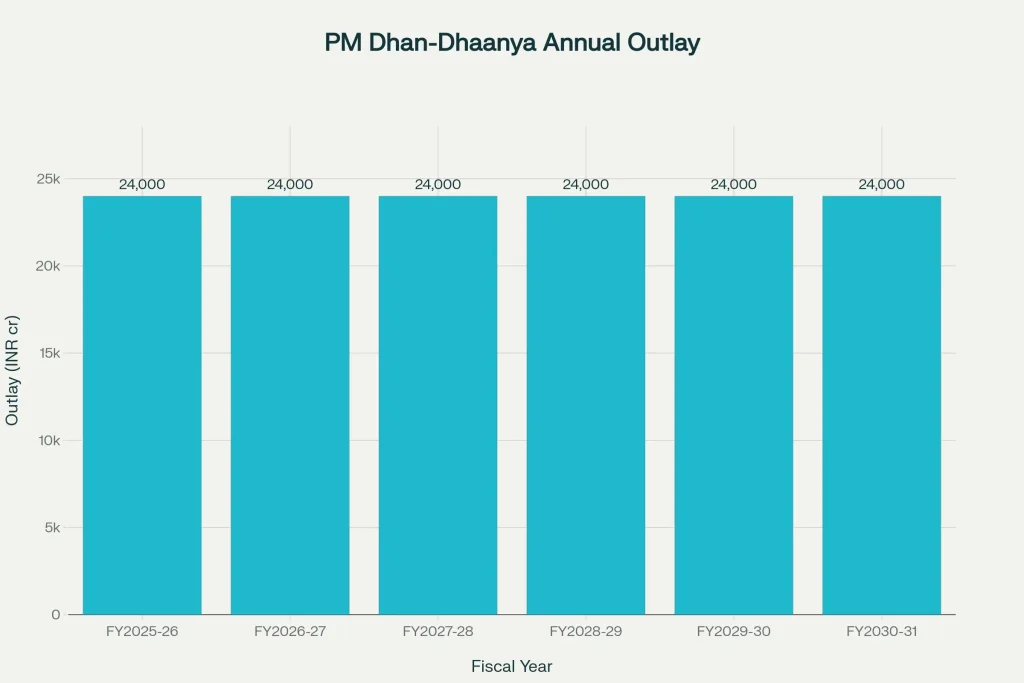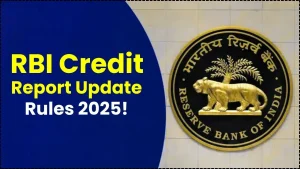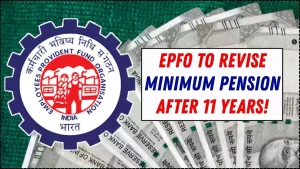PM Dhan-Dhaanya Krishi Yojana is a six-year, ₹1.44 lakh crore national mission designed to lift farm productivity, expand irrigation and storage, and raise smallholder incomes across 100 underperforming districts. Built on the convergence of multiple agriculture and allied schemes, it prioritizes data-driven delivery, district-level planning, and measurable outcomes for farmers most in need.

PM Dhan-Dhaanya Krishi Yojana is focused on closing yield gaps, improving water-use efficiency, and strengthening credit, insurance, and market linkages for farmers in structurally weaker districts. With an annual outlay of ₹24,000 crore from FY 2025-26 to 2030-31, the initiative coordinates interventions like micro-irrigation, post-harvest storage, local processing, and farmer advisory services to reduce losses and stabilize incomes. Modeled on proven district-transformation frameworks, it aligns local agriculture plans with national priorities on diversification, soil health, and natural/organic farming to deliver tangible results on the ground.
PM Dhan Dhaanya Krishi Yojana
| Key Item | Details |
|---|---|
| Duration | FY 2025-26 to FY 2030-31 (six years) |
| Annual Outlay | ₹24,000 crore (Total ₹1.44 lakh crore) |
| Coverage | 100 underperforming agriculture districts (at least one per state/UT) |
| Beneficiaries | Approximately 1.7 crore farmers, with priority to small and marginal |
| Delivery Model | Convergence of existing central and state schemes in agriculture and allied sectors |
| Selection Indicators | Low productivity, low cropping intensity, low institutional credit |
| Planning Mechanism | District Dhan Dhaanya Samiti prepares Agriculture and Allied Activities Plan |
| Monitoring | Monthly dashboard tracking with a broad KPI set and multi-tier reviews |
| Focus Areas | Irrigation, storage, processing, credit and insurance, diversification, sustainability |
For farmers, the payoff is practical: more assured irrigation, fewer post-harvest losses, easier institutional credit and crop insurance, and stronger pathways to better prices through aggregation and value addition. For states and districts, the mission offers a framework that aligns plans, budgets, and accountability so assets don’t sit idle and services don’t fragment. And for the wider agri-economy, it nudges a shift from volume to value diversification, processing, and sustainability so productivity gains translate into resilient incomes.
Objectives And Design of PM Dhan Dhaanya Krishi Yojana
The mission aims to elevate productivity and incomes by saturating gaps in irrigation, storage, processing, credit access, and extension support. It emphasizes water conservation, micro-irrigation, and on-farm water management to increase cropping intensity. By reducing post-harvest losses through decentralized storage and encouraging value addition via processing, the program targets improvements in both farm output and price realization.
Why These 100 Districts
Districts are selected using objective indicators where interventions can deliver the largest marginal gains. Low productivity, low cropping intensity, and limited credit penetration are the core selection criteria. Ensuring at least one district per state/UT marries impact with equity, while proportional allocation by cropped area and operational holdings reflects agricultural footprint and need.
Convergence And Funding in PM Dhan Dhaanya Krishi Yojana
Instead of creating a new silo, the mission synchronizes dozens of ongoing programs under one umbrella to reduce duplication and speed up execution. Funds are planned and predictable over six years, enabling phased investments in irrigation assets, on-farm infrastructure, storage and processing, and farmer services. This convergence approach simplifies last-mile delivery and encourages partnerships with state schemes and local private players where they add value.
Planning And Governance
Each district forms a Dhan Dhaanya Samiti with participation from progressive farmers to craft a context-aware Agriculture and Allied Activities Plan. State- and national-level committees align planning, approvals, and monitoring. Central nodal coordination ensures that bottlenecks are flagged early and resolved, while district teams stay focused on delivery, farmer outreach, and timely utilization of funds.
Monitoring And Accountability
A comprehensive set of performance indicators is tracked on a monthly dashboard to keep stakeholders aligned and accountable. Regular reviews help recalibrate priorities and resources based on ground feedback. The model borrows from successful district-transformation playbooks where transparent measurement and course correction drive outcomes, not just outlays.
What Farmers Can Expect
- Irrigation Upgrades: Micro-irrigation, water harvesting, and on-farm distribution to stabilize yields and lift cropping intensity.
- Storage And Processing: Panchayat/block-level storage, primary processing, and value-add units to reduce distress sales and improve quality retention.
- Credit And Insurance Access: Easier access to institutional credit and crop insurance to fund inputs and mitigate risk from weather and market shocks.
- Advisory And Diversification: Agronomic support for crop diversification, better seeds, and sustainable practices to improve margins and resilience.
- Market Linkages And FPOs: Stronger farmer collectives and local value chains to aggregate produce, negotiate better prices, and expand market access.
Strategic Alignment
The mission dovetails with national goals on self-reliance in key crops, sustainable water use, soil health improvement, and organic/natural farming expansion. It also complements parallel sectoral pushes in pulses, livestock, fisheries, and food processing to build end-to-end value chains from farm to storage to market so productivity gains translate into higher, steadier incomes.

Eligibility and Beneficiary Criteria for PM Dhan Dhaanya Krishi Yojana
The primary beneficiaries are farmers in the selected districts, with a clear emphasis on small and marginal farmers. District-wise saturation strategies ensure that interventions reach a critical mass of households, enabling visible and measurable improvements in yields, losses, and price realization within the mission period.
Timelines And Budgeting
Running from FY 2025-26 through FY 2030-31, the scheme’s multi-year horizon is designed for compounding benefits. Year one often prioritizes water and basic infrastructure, followed by storage and processing, with credit facilitation, advisory, and market linkages layered in. The steady annual outlay supports consistent district planning, contractor mobilization, and farmer adoption cycles.
Tripura Government Launches New Programs to Promote Women’s Dignity and Social Equality
On-Ground Impact Pathways
- Yield Lift: Better irrigation and inputs raise per-hectare output, narrowing the gap with national benchmarks.
- Loss Reduction: Storage and primary processing at the local level prevent quality degradation and shrink post-harvest losses.
- Price Realization: Aggregation, grading, and linkages help farmers capture value beyond the farm-gate.
- Risk Management: Insurance and credit smooth cash flows and enable productivity-enhancing investments.
- Sustainability: Soil health, water efficiency, and diversified cropping reduce vulnerability to climate variability.
FAQs on PM Dhan Dhaanya Krishi Yojana
Who Is Eligible Under This Mission?
Farmers in the 100 selected districts are eligible, with priority to small and marginal farmers. District selection is based on low productivity, low cropping intensity, and limited credit access.
How Long Will It Run and What Is the Budget
The mission runs for six years, from FY 2025-26 to FY 2030-31, with an annual outlay of ₹24,000 crore, totaling ₹1.44 lakh crore.
What Interventions Are Covered?
Key interventions include irrigation expansion, on-farm water management, decentralized storage and primary processing, easier credit and insurance access, and advisory support for diversification and sustainable practices.
How Will Progress Be Tracked?
A broad KPI framework is monitored monthly through dashboards and multi-tier reviews to ensure accountability and timely course correction.
















